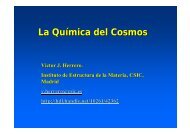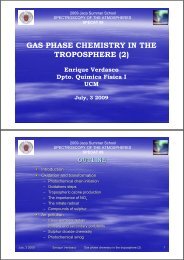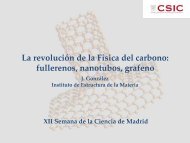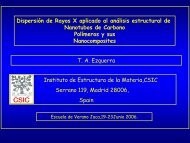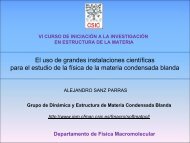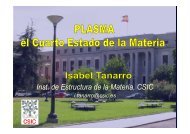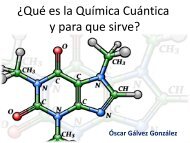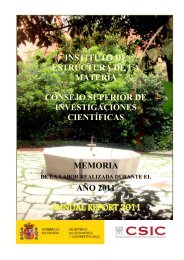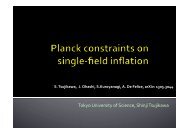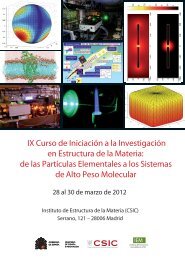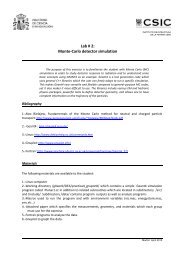Aproximación dinámica a sistemas macromoleculares - Instituto de ...
Aproximación dinámica a sistemas macromoleculares - Instituto de ...
Aproximación dinámica a sistemas macromoleculares - Instituto de ...
You also want an ePaper? Increase the reach of your titles
YUMPU automatically turns print PDFs into web optimized ePapers that Google loves.
IX CURSO DE INICIACIÓN A LA INVESTIGACIÓN EN<br />
ESTRUCTURA DE LA MATERIA<br />
BIOPHYM<br />
2012<br />
Aproximación dinámica a<br />
<strong>sistemas</strong><br />
<strong>macromoleculares</strong><br />
Javier Martínez <strong>de</strong> Salazar<br />
(BIOPHYM)<br />
Departamento <strong>de</strong> Fisica Macromolecular<br />
<strong>Instituto</strong> <strong>de</strong> Estructura <strong>de</strong> la Materia – CSIC<br />
http://www.biophym.iem.csic.es/biophym
BIOPHYM<br />
2011<br />
Programas <strong>de</strong> investigación<br />
breves para estudiantes <strong>de</strong><br />
últimos cursos<br />
http://www.biophym.iem.csic.es/biophym<br />
http://www.gemppo.iem.csic.es/gemppo
BIOPHYM UN GRUPO QUE EVOLUCIONA Y SE ADAPTA<br />
ESTRUCTURA DE MEMBRANAS CELULARES-<br />
DISTORSIONES POR PROTEÍNAS<br />
1976-1994<br />
morphology/structure vs.<br />
Physical properties (solid)<br />
1996-2004<br />
molecular architecture vs.<br />
physical properties melt<br />
Computational chemistry<br />
(MM and QM, DFT)<br />
2004 - 2008<br />
Macromolecular simulation<br />
(MC, MD): crystallization +<br />
melt<br />
2008 - 2012<br />
Macromolecular/ BIO<br />
Nace biophym
ALGUNAS IDEAS DE INTERÉS SOBRE<br />
MACROMOLÉCULAS PARA ESTUDIANTES FÍSICOS Y<br />
FISICO-QUIMICOS
LAS MACROMOLÉCULAS CONSTITUYEN UN SISTEMA QUE SE AUTO-<br />
ORGANIZA<br />
La macromolécula se configura como el elemento estructural y funcional <strong>de</strong> la vida<br />
yute<br />
lino bonote abacá ramio sisal cáñamo algodón<br />
alpaca angora mohair cachemir camello lana seda
MACROMOLÉCULAS SINTÉTICAS (POLÍMEROS)<br />
Enorme importancia tecnológica como materiales <strong>de</strong> uso<br />
Primeras macromoléculas sintéticas<br />
Caucho Vulcanizado<br />
(1839 )<br />
Baquelita<br />
(1907 )<br />
Charles Goodyear<br />
Leo Baekeland
Personajes claves <strong>de</strong> la física <strong>de</strong> MACROMOLECULAS<br />
Hermann Staudinger<br />
En 1953 recibió el Premio Nobel <strong>de</strong> Química «por sus <strong>de</strong>scubrimientos en<br />
el campo <strong>de</strong> la química macromolecular<br />
La hipótesis macromolecular<br />
Paul J. Flory<br />
En 1974 le fue concedido el Premio Nobel <strong>de</strong> Química por sus estudios,<br />
teóricos y prácticos, en la fisicoquímica <strong>de</strong> las macromoléculas<br />
Inició su investigación en la compañía farmacéutica DuPont<br />
Ovillo estadístico<br />
Pierre-Gilles <strong>de</strong> Gennes<br />
En 1991 le fue concedido el Premio Nobel <strong>de</strong> Física por "el <strong>de</strong>scubrimiento y<br />
<strong>de</strong>sarrollo <strong>de</strong> métodos avanzados para estudiar los fenómenos simples <strong>de</strong> los<br />
materiales, para crear formas más complejas <strong>de</strong> materia, en particular, cristales<br />
líquidos y polímeros".<br />
reptación
Las macromoléculas adoptan conformaciones extremas<br />
plegada<br />
laminas<br />
200 nm<br />
extendida<br />
fibras
Se organizan en una Red cooperativa con efectos no lineales<br />
UNO AFECTA A TODOS<br />
Las macromoléculas forman un sistema (red <strong>de</strong><br />
entrecruzamientos) en la que cada elemento (molécula)<br />
repta en un tubo cuyo contorno queda fijado por el resto<br />
Se manifiestan fenómenos cooperativos (<strong>sistemas</strong> altamente correlacionados)
EL SISTEMA ES MÁS QUE LA SUMA DE SUS ELEMENTOS (FORMAN ESTRUCTURAS COMPLEJAS)<br />
Na +<br />
Cl -<br />
Cristal NaCl<br />
REGIONES<br />
CRISTALINAS<br />
POLIMEROS SEMICRISTALINOS<br />
REGIONES<br />
AMORFAS
Forman Re<strong>de</strong>s viscoelásticas --- buenos MATERIALES<br />
Mol<strong>de</strong>ado<br />
Extrusión<br />
soplado<br />
fibras<br />
Deformable<br />
(Procesabilidad)<br />
aplicaciones
Muchas preguntas básicas sin respuesta<br />
Cómo solidifican los polímeros?<br />
teorías al uso no válidas<br />
PARADIGMAS INVÁLIDOS<br />
Como se forman las fases en el fundido?<br />
la termodinámica no da respuesta
Por qué hacer dinámica macromolecular?<br />
<br />
TRATAMOS CON SISTEMAS MULTICOMPONENTE EN EL QUE<br />
SUS ELEMENTOS SE ORGANIZAN ESTRUCTURALMENTE<br />
DANDO LUGAR A FENÓMENOS NO PREDECIBLES POR LAS<br />
TEORIAS EXISTENTES<br />
SERIAS LIMITACIONES EN LA OBTENCIÓN DE SEÑALES<br />
EXPERIMENTALES
Combinación <strong>de</strong> experimentos y simulación<br />
Proceso <strong>de</strong> feedback<br />
Imagen virtual<br />
Imagen real
Sinergia experimentación-simulación<br />
Distribución <strong>de</strong> peso<br />
molecular<br />
Centro activo único<br />
W<br />
<br />
Ziegler-Natta<br />
Phillips o radicalaria<br />
<br />
<br />
<br />
<br />
<br />
FENE potential<br />
Abstracción<br />
Simplificación<br />
where, r c = 2 1/6 s<br />
<br />
Modificación<br />
<br />
Parametrización<br />
Abstracción<br />
Implementación<br />
<br />
+<br />
dC/dT<br />
0<br />
1.5 2.0 2.5 3.0 3.5 4.0<br />
log Z<br />
0.30<br />
0.25<br />
0.20<br />
0.15<br />
0.10<br />
0.05<br />
0.00<br />
20 30 40 50 60 70 80 90<br />
T (ºC)<br />
<br />
Force Field (Å 2 ) (Å 2 ) C∞ c lp (Å) d Me (kg/mol) e<br />
Trappe-UA a 19805 ± 50 3299 ± 6 6.00 ± 0.03 8.34 ± 0.01 9.22 ± 0.02 0.71 ± 0.01<br />
Karayiannis et al. b 19335 ± 56 3187 ± 6 6.07 ± 0.03 8.06 ± 0.01 9.54 ± 0.02 0.79 ± 0.01<br />
log(g<br />
1<br />
) (Å 2 )<br />
Distribución <strong>de</strong> comonómero<br />
T p (ºC)<br />
90<br />
80<br />
70<br />
60<br />
50<br />
40<br />
0 1 2 3 4 5<br />
Styrene-% mol<br />
3.2<br />
2.8<br />
2.4<br />
t e =1.3 ns<br />
1/4<br />
<br />
1.6 2.0 2.4 2.8 3.2 3.6 4.0 4.4 4.8<br />
log(t) (ps)<br />
Métodos<br />
<br />
<br />
2.0<br />
1.6<br />
1/2
PASOS A SEGUIR EN DINÁMICA MOLECULAR<br />
SE CONSTRUYE EL MODELO VIRTUAL<br />
SE ELIGEN LAS CONDICIONES INICIALES<br />
SE VALIDA EXPERIMENTALMENTE<br />
SE LE DEJA EVOLUCIONAR DE ACUERDO A LAS<br />
LEYES DE LA DINÁMICA CLÁSICA<br />
SE SIMULAN PERTURBACIONES<br />
SE ESTUDIAN LAS TRAYECTORIAS<br />
SE CONTRASTAN LOS ESTADOS CON LOS<br />
EXPERIMENTOS
PROBLEMA DE LAS ESCALAS DE ESPACIO-TEMPORALES.<br />
ES NECESARIA LA SIMULACIÓN MULTI-ESCALA<br />
Temporal scale:<br />
Length scale:<br />
~fs- ps ~ns- μs<br />
~ μs-ms >s<br />
Bond Vibrations<br />
Conformational<br />
transitions<br />
Microphase separation<br />
Physical ageing in glass
Abarcar más: mo<strong>de</strong>los <strong>de</strong> "grano grueso" polímeros (Coarsed grain mo<strong>de</strong>ls)<br />
United Atom aproximation<br />
Systematic Coarse-Graining Procedure<br />
Atactic Polystyrene<br />
Atomistic simulations<br />
of short chains<br />
V streching (l) →V bending (q)→V nonbon<strong>de</strong>d (r)<br />
Boltzmann Inversion<br />
Transferable potentials for phase<br />
Equilibria Force Field (TraPPE-UA):<br />
Parámetros obtenidos por ajuste a datos<br />
experimentales<br />
Martin MG et al, JPCB, 102, 2564, 1998<br />
Milano G et al, JPCB, 109, 18609, 2005<br />
Spyrioni T et al, Macromolecules, 40, 3876, 2007
Líneas <strong>de</strong> investigación en macromoléculas sintéticas<br />
Mo<strong>de</strong>lización <strong>de</strong> las reacciones <strong>de</strong><br />
polimerización mediante catalizadores<br />
organometálicos.<br />
J. Ramos, S. Martínez, V.L. Cruz and J. Martínez-Salazar, J. Molecuar Mod. (2011)<br />
J. Ramos, V. L. Cruz, J. Martínez-Salazar, M. Brasse, P. Palma and J. Campora J Pol Sci: Pol Chem (2010)<br />
Comportamiento viscoelástico y dinámica<br />
molecular <strong>de</strong> polímeros sintéticos<br />
Copolimeros <strong>de</strong> etileno<br />
y metacrilato.<br />
Biocompatibilidad<br />
Procesabilidad<br />
Viscoelasticidad<br />
J.F. Vega, J.Ramos and J. Martínez-Salazar, Rheologica Acta (2011)<br />
J. Ramos, J.F. Vega, D.N. Theodorou and J. Martínez-Salazar, Macromolecules (2008)<br />
Cristalización <strong>de</strong> polímeros en disolución. Efecto<br />
<strong>de</strong> la arquitectura molecular<br />
Teorías <strong>de</strong><br />
cristalización<br />
Propieda<strong>de</strong>s<br />
mecánicas<br />
S. Sanmartín, J. Ramos and J. Martínez-Salazar Macromolecular Symposia (2011)<br />
J. Ramos and J. Martínez-Salazar J Pol Sci: Pol Phys (2011)
EXPERIMENTACIÓN Y SIMULACION DEL CRECIMIENTO DE MONOCRISTALES<br />
200 nm<br />
a)<br />
Global Bond Orientation Or<strong>de</strong>r S<br />
0.9<br />
0.8<br />
0.7<br />
0.6<br />
0.5<br />
0.4<br />
0.3<br />
0.2<br />
0.1<br />
0.0<br />
PE-00<br />
PE-05<br />
PE-10<br />
200<br />
nm<br />
b)<br />
14 13 12 11 10 9 8 7 6<br />
Reduced Temperature<br />
0.0<br />
-0.1<br />
-0.2<br />
PE-00<br />
PE-05<br />
PE-10<br />
dS/dT*<br />
-0.3<br />
-0.4<br />
-0.5<br />
11.19<br />
10.82<br />
Cristallinity (a)<br />
0,8<br />
0,7<br />
0,6<br />
0,5<br />
0,4<br />
0,00 0,01 0,02 0,03 0,04 0,05<br />
Experimental values from reference 24<br />
Simulated values<br />
0,00 0,01 0,02 0,03 0,04 0,05<br />
C 4<br />
Branch Fraction<br />
-0.6<br />
11.58<br />
-0.7<br />
14 13 12 11 10 9 8 7 6<br />
Reduced Temperature (T*)<br />
Table 2: Simulated <strong>de</strong>nsities as a function of the <strong>de</strong>gree of branching.<br />
PE-00 PE-05 PE-10<br />
Crystallyne(ρ c ) 0.933 0.917 0.915<br />
Amorphous(ρ a ) 0.858 0.863 0.860<br />
Amorphous experimental 25 0.861<br />
Total(ρ) a 0.906 0.889 0.882<br />
Total Experimental 25 0.952 0.931 0.922<br />
a Calculated as: ρ c = αρ c +(1-α)ρ a where α is the simulated crystallinity reported in Fig 8. Experimental<br />
values are in italics style. Units are given in g/cm 3 .
estructura <strong>de</strong>l fundido y procesos <strong>de</strong> solidificación
BIOFISICA
Primeras incursiones en biofísica (1975-1982)<br />
(estructura <strong>de</strong> membranas por difracción <strong>de</strong> rayos X)<br />
Estructura <strong>de</strong> las bicapas lipídicas<br />
Distorsiones paracristalinas por<br />
la presencia <strong>de</strong> proteínas
Biofísica actual en biophym<br />
Biologia evolutiva<br />
(evolución <strong>de</strong> poblaciones)<br />
Dinámica <strong>de</strong> <strong>sistemas</strong><br />
Dinámica evolutiva<br />
tres líneas <strong>de</strong> investigación<br />
en <strong>de</strong>sarrollo<br />
Ibercivis-grid<br />
NEUROTRANSMISORES QUE MEDIAN<br />
EN LOS TRANSTORNOS DEL ESTADO<br />
DE ANIMO<br />
TRANSMISIÓN DE SEÑALES<br />
Receptores <strong>de</strong> proteínas<br />
en membranas
RECEPTORES CANABINOIDES EN MEMBRANA LIPÍDICA<br />
SNC, Reproductivo,<br />
Inmune y digestivo<br />
Cannabinoi<strong>de</strong>s: Uso “recreativo”<br />
(ilegal) y uso terapéutico (glaucoma,<br />
vómitos inducidos por quimio,<br />
analgésico en cáncer y esclerosis<br />
múltiple)<br />
Pulmón, bazo y<br />
testículos<br />
CB-1<br />
CB-2
ErbB1 (EGFR), ErbB2, ErbB3 implicados en el <strong>de</strong>sarrollo y proliferación <strong>de</strong>l cáncer.<br />
ErbB4 implicada en la inhibición <strong>de</strong> crecimiento más que en la proliferación<br />
Cancer Cell 13 (2008) 291<br />
PNAS 105 (2008) 6109<br />
BMC Systems Biology 3:1 (2009) 1
BIOPHYM HOY<br />
REPSOL<br />
DOW CHEMICAL<br />
FINANCIACIÓN POR PROYECTOS<br />
PÚBLICOS Y CONTRATOS CON<br />
EMPRESAS<br />
Colaboraciones con empresas multinacionales<br />
(Procesos <strong>de</strong> cristalización y estructura <strong>de</strong> fases en matrices<br />
poliméricas)<br />
ESTUDIO DE LA PROPAGACIÓN DE<br />
LA ENFERMEDAD DE CHAGAS<br />
GRUPO<br />
INTERDISCIPLINAR<br />
(Fisicos, Quimicos, Biologos, informáticos)<br />
PROTEINAS MEDIADORAS DEL CANCER<br />
Colaboraciones externas otros grupos<br />
(<strong>de</strong>sarrollos <strong>de</strong> herramientas <strong>de</strong> computación)<br />
Participación en Ibercivis-grid<br />
ESTRUCTURA FUNCIONAL DE<br />
NEUROPÉTIDOS-TRANSTORNOS<br />
DEL ESTADO DE ANIMO<br />
HOSPITAL VAL D’HEBRON<br />
SINO BIOLOGICAL
OUTPUTS: ARTÍCULOS Y CITAS<br />
Nº <strong>de</strong> citas acumulado<br />
2400<br />
2100<br />
1800<br />
1500<br />
1200<br />
900<br />
600<br />
300<br />
250<br />
200<br />
150<br />
100<br />
50<br />
0<br />
2000 2002 2004 2006 2008 2010 2012<br />
0<br />
2000 2002 2004 2006 2008 2010 2012<br />
Año<br />
Indice <strong>de</strong> impacto<br />
15<br />
12<br />
9<br />
6<br />
3<br />
Biophym (13.5 citas/articulo)<br />
Macromolecules (4.837)<br />
Organometalics (4.204)<br />
Polymer (3.573)<br />
Física<br />
Ciencia <strong>de</strong> Materiales<br />
0<br />
1998 2000 2002 2004 2006 2008 2010 2012<br />
Año
Resultados recientes <strong>de</strong> estudiantes <strong>de</strong> pregrado por estancias cortas en Biophym<br />
Grisel Zapino Guzmán<br />
TESIS DE PASANTIA<br />
Propieda<strong>de</strong>s viscoelásticas<br />
en estado fundido y estudio<br />
<strong>de</strong> los fenómenos <strong>de</strong><br />
orientación en mezclas <strong>de</strong><br />
poliolefinas, Septiembre<br />
2011<br />
Yudith A. da Silva Caires<br />
TESIS DE PASANTIA<br />
Efecto <strong>de</strong> la estructura molecular en la<br />
respuesta viscoelástica <strong>de</strong> nanocompuestos<br />
<strong>de</strong> polietileno y nanotubo, Octubre 2011<br />
Mención <strong>de</strong> Honor<br />
Karina Jerónimo Martínez<br />
TESIS DE PASANTIA<br />
Simulación <strong>de</strong>l crecimiento <strong>de</strong><br />
moléculas <strong>de</strong> PE en presencia<br />
<strong>de</strong> nanotubos <strong>de</strong> carbono,<br />
Enero 2012<br />
Mención <strong>de</strong> Honor<br />
Adriana Jargour Pinto<br />
TESIS DE PASANTIA<br />
Propieda<strong>de</strong>s viscoelásticas en el<br />
régimen lineal en estado fundido<br />
<strong>de</strong> mezclas <strong>de</strong> poliolefinas,<br />
Abril 2012<br />
Estancias cortas: 2011-2012<br />
Nathalie Jargour Pinto<br />
TESIS DE PASANTIA<br />
Morfología <strong>de</strong> monocristales<br />
<strong>de</strong> polietileno ramificado en<br />
disolución diluída, Abril 2012<br />
Ernesto Vicente Alique<br />
Beca JAE Intro -CSIC<br />
Size and conformational<br />
features of ErbB2 and ErbB3<br />
receptors: a TEM and DLS<br />
comparative study. European<br />
Biophysical Journal 40, 835-<br />
842 (2011)
MUCHAS GRACIAS POR VUESTRA ATENCIÓN<br />
OS ESPERAMOS EN BIOPHYM




